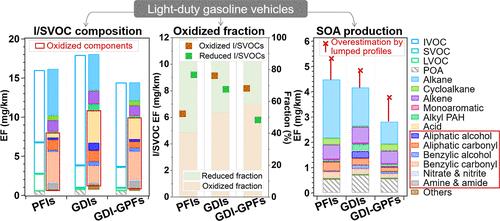轻型汽油车辆中特定的中等挥发性和半挥发性有机化合物(I/SVOCs):发动机和后处理技术的影响
IF 11.3
1区 环境科学与生态学
Q1 ENGINEERING, ENVIRONMENTAL
引用次数: 0
摘要
轻型汽油车(ldgv)的中挥发性(IVOCs)和半挥发性有机化合物(SVOCs)是二次有机气溶胶(SOA)的主要前体,但在不断发展的发动机和后处理技术下,它们的排放特性仍然知之甚少。在这项研究中,二维气相色谱-质谱(GC - ms) (GC × GC - ms)从LDGV尾气中解析了2000多种有机物质,从而实现了采用进气道燃油喷射(PFI)和汽油直喷(GDI)发动机的车辆的精确排放剖面。含氧化合物,主要是酸和羰基,占气态I/SVOCs的40.5-58.5%。尽管测试车队的平均I/SVOC排放系数没有显著差异,但PFI车辆排放的减少物种更多,可能是由于燃烧效率较低。相比之下,GDI发动机显著提高了氧化I/SVOC丰度45.6%,特别是在中等挥发性范围内,并增加了排放有机物的总体氧化态。此外,汽油微粒过滤器(GPFs)的使用增加了苯羰基的排放,表明潜在的氧化作用。在冷启动条件下,特别是在较低的环境温度下,I/SVOC排放量进一步升高。将氧化IVOCs纳入排放剖面,将IVOCs与总气态有机物的比率提高到27.8%,并将SOA预测偏差纠正了38.2%。这些发现强调了在排放控制策略中优先考虑I/SVOCs和提高SOA建模准确性的必要性。本文章由计算机程序翻译,如有差异,请以英文原文为准。

Speciated Intermediate-Volatility and Semivolatile Organic Compounds (I/SVOCs) from Light-Duty Gasoline Vehicles: Impacts of Engine and Aftertreatment Technologies
Intermediate-volatility (IVOCs) and semivolatile organic compounds (SVOCs) from light-duty gasoline vehicles (LDGVs) are major precursors of secondary organic aerosol (SOA), yet their emission characteristics under evolving engine and aftertreatment technologies remain poorly understood. In this study, two-dimensional gas chromatography–mass spectrometry (GC–MS) (GC × GC–MS) resolved over 2000 organic species from LDGV exhausts, enabling refined emission profiles across vehicles with port fuel injection (PFI) and gasoline direct injection (GDI) engines. Oxygenated compounds, primarily acids and carbonyls, accounted for 40.5–58.5% of gaseous I/SVOCs. Although average I/SVOC emission factors showed no significant differences across the testing fleet, PFI vehicles emitted more reduced species, likely due to a lower combustion efficiency. In contrast, GDI engines significantly enhanced oxidized I/SVOC abundances by 45.6%, particularly within the intermediate-volatility range, and increased the overall oxidation state of the emitted organics. Furthermore, the application of gasoline particulate filters (GPFs) increased benzylic carbonyl emissions, suggesting potential oxidative effects. Under cold-start conditions, especially at low ambient temperatures, I/SVOC emissions were further elevated. Incorporating oxidized IVOCs into emission profiles refined the IVOC-to-total gaseous organics ratio to 27.8% and also corrected SOA prediction biases by up to 38.2%. These findings underscore the need to prioritize I/SVOCs in emission control strategies and improve SOA modeling accuracy.
求助全文
通过发布文献求助,成功后即可免费获取论文全文。
去求助
来源期刊

环境科学与技术
环境科学-工程:环境
CiteScore
17.50
自引率
9.60%
发文量
12359
审稿时长
2.8 months
期刊介绍:
Environmental Science & Technology (ES&T) is a co-sponsored academic and technical magazine by the Hubei Provincial Environmental Protection Bureau and the Hubei Provincial Academy of Environmental Sciences.
Environmental Science & Technology (ES&T) holds the status of Chinese core journals, scientific papers source journals of China, Chinese Science Citation Database source journals, and Chinese Academic Journal Comprehensive Evaluation Database source journals. This publication focuses on the academic field of environmental protection, featuring articles related to environmental protection and technical advancements.
 求助内容:
求助内容: 应助结果提醒方式:
应助结果提醒方式:


